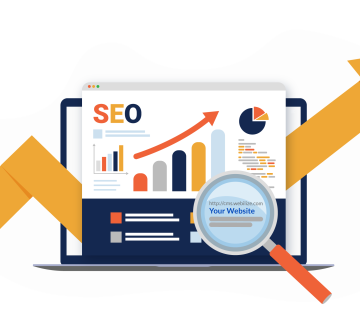How to Create a Custom E-Commerce Website in 6 Easy Steps?

It is not required, nor even advised, to start from scratch when creating an e-commerce website. You don’t need to be very technical or proficient in coding to start an online store, thanks to a variety of platforms. However, there are other things you must do before beginning the development process, in addition to choosing your platform. Before you jump right in, take into account the following:
1. Understand your business goals.
Choosing to sell online is a major one. Furthermore, until you understand the operating bells and whistles, you are unable to take further action.

To begin with, consider why.
-
- You want to sell online, but why?
- To draw in additional business is simple. However, precisely how are you going to accomplish that?
- Will you do direct-to-consumer sales through your e-commerce company?
- Do you wish to increase internet visitors in addition to your offline business ventures?
- Should you grow your firm from B2C to B2B or the other way around?
Beyond your initial objectives, consider e-commerce analytics.
-
- After the launch, what type of growth are you hoping for, and how will you gauge it?
- What is your target volume of weekly online sales, for instance?
- Do you also want to sell abroad or locally?
- How do you intend to increase the lifetime value of a customer?
- How much merchandise do you intend to sell?
2. Understand the intended shopping experience.

What type of virtual retail encounter do you hope to provide for your clients?
The following are a few experience elements you might wish to take into account:
-
- Allowing your clients to quickly and easily select search results based on factors like price, size, or colour.
- The capability of side-by-side product comparisons.
- Providing a one-page checkout process that is optimized.
- Discounts, specials, and other offerings.
Consider whether your target market prefers to explore your website for a while and find new things, or if they want a quick and easy purchase experience, as they do with needs like some consumer-packaged goods. Depending on your response, you may want to design your website for a distinct consumer path.
3. Discuss platform options.

Fortunately, you no longer need to start from zero when creating an online business. You may select the ideal e-commerce solution for your requirements from a wide range of options.
The many e-commerce platforms available have their pros and cons, so it’s important to know precisely what features you require to maximize the potential of your online business.
The most well-liked e-commerce website builders are Shopify or Shopify Plus, BigCommerce, Magento, and WooCommerce. Alternatively, WordPress is a popular choice for merchants with content-rich websites. BigCommerce and other e-commerce systems allow you to integrate your content with your business.
4. Add products.
Ensure that adding and editing product listings is a simple process for you and that your inventory is synchronized with all of your sales channels. By doing this, you may streamline back-office processes and prevent overselling of your goods.
When you do add items, you should pay attention to the following:
-
- Superior product photos: Assure your clients that they will receive precisely what they want when they place an order with you.
- In-depth descriptions of the products: Please ensure that you provide all relevant information, product specs, size information, etc., especially for goods that have undergone extensive study.
5. Set payment and shipping settings.

A website developer may help with the checkout and shopping cart processes, as well as with setting up shipping and integrating payment methods into your website. Usually, you’ll have a wide selection of payment gateways.
Although it’s not necessary to integrate them all, clients are showing a growing desire to make payments using a variety of options, such as purchase now, pay later. Additionally, if you’re selling internationally, you should select payment gateways that are compatible with the areas you wish to reach.
6. QA and launch the website.
Give your website a brief test run after it goes from the stage to production to make sure you’re satisfied with the navigation, performance, and style of your e-commerce website.

Here is a short to-do list:
-
- Examine each form headline and call to action on the landing page and homepage.
- Try out the checkout process.
- Verify again the integrations for payment processing (credit cards, PayPal, Stripe, etc.).
- Ensure that every image is optimized for load speed while maintaining excellent definition.
- Seek out any product descriptions and categories that are lacking.
- Verify the functionality of all forms and connections.
- Check to make sure your tax settings are accurate.
- Make sure every item in the inventory is accurately listed.
- Check your promo codes and vouchers.
Additionally, make sure that the user experience is consistent across all platforms and that your digital storefront looks great on both desktop and mobile devices.
For more details visit : Justclickshop.com
How to Create a Custom E-Commerce Website in 6 Easy Steps?

It is not required, nor even advised, to start from scratch when creating an e-commerce website. You don’t need to be very technical or proficient in coding to start an online store, thanks to a variety of platforms. However, there are other things you must do before beginning the development process, in addition to choosing your platform. Before you jump right in, take into account the following:
1. Understand your business goals.
Choosing to sell online is a major one. Furthermore, until you understand the operating bells and whistles, you are unable to take further action.

To begin with, consider why.
-
- You want to sell online, but why?
- To draw in additional business is simple. However, precisely how are you going to accomplish that?
- Will you do direct-to-consumer sales through your e-commerce company?
- Do you wish to increase internet visitors in addition to your offline business ventures?
- Should you grow your firm from B2C to B2B or the other way around?
Beyond your initial objectives, consider e-commerce analytics.
-
- After the launch, what type of growth are you hoping for, and how will you gauge it?
- What is your target volume of weekly online sales, for instance?
- Do you also want to sell abroad or locally?
- How do you intend to increase the lifetime value of a customer?
- How much merchandise do you intend to sell?
2. Understand the intended shopping experience.

What type of virtual retail encounter do you hope to provide for your clients?
The following are a few experience elements you might wish to take into account:
-
- Allowing your clients to quickly and easily select search results based on factors like price, size, or colour.
- The capability of side-by-side product comparisons.
- Providing a one-page checkout process that is optimized.
- Discounts, specials, and other offerings.
Consider whether your target market prefers to explore your website for a while and find new things, or if they want a quick and easy purchase experience, as they do with needs like some consumer-packaged goods. Depending on your response, you may want to design your website for a distinct consumer path.
3. Discuss platform options.

Fortunately, you no longer need to start from zero when creating an online business. You may select the ideal e-commerce solution for your requirements from a wide range of options.
The many e-commerce platforms available have their pros and cons, so it’s important to know precisely what features you require to maximize the potential of your online business.
The most well-liked e-commerce website builders are Shopify or Shopify Plus, BigCommerce, Magento, and WooCommerce. Alternatively, WordPress is a popular choice for merchants with content-rich websites. BigCommerce and other e-commerce systems allow you to integrate your content with your business.
4. Add products.
Ensure that adding and editing product listings is a simple process for you and that your inventory is synchronized with all of your sales channels. By doing this, you may streamline back-office processes and prevent overselling of your goods.
When you do add items, you should pay attention to the following:
-
- Superior product photos: Assure your clients that they will receive precisely what they want when they place an order with you.
- In-depth descriptions of the products: Please ensure that you provide all relevant information, product specs, size information, etc., especially for goods that have undergone extensive study.
5. Set payment and shipping settings.

A website developer may help with the checkout and shopping cart processes, as well as with setting up shipping and integrating payment methods into your website. Usually, you’ll have a wide selection of payment gateways.
Although it’s not necessary to integrate them all, clients are showing a growing desire to make payments using a variety of options, such as purchase now, pay later. Additionally, if you’re selling internationally, you should select payment gateways that are compatible with the areas you wish to reach.
6. QA and launch the website.
Give your website a brief test run after it goes from the stage to production to make sure you’re satisfied with the navigation, performance, and style of your e-commerce website.

Here is a short to-do list:
-
- Examine each form headline and call to action on the landing page and homepage.
- Try out the checkout process.
- Verify again the integrations for payment processing (credit cards, PayPal, Stripe, etc.).
- Ensure that every image is optimized for load speed while maintaining excellent definition.
- Seek out any product descriptions and categories that are lacking.
- Verify the functionality of all forms and connections.
- Check to make sure your tax settings are accurate.
- Make sure every item in the inventory is accurately listed.
- Check your promo codes and vouchers.
Additionally, make sure that the user experience is consistent across all platforms and that your digital storefront looks great on both desktop and mobile devices.
For more details visit : Justclickshop.com




No comment